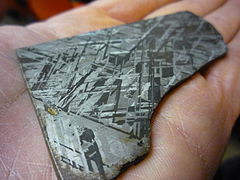Kamacyt
 Figury Widmanstättena kamacytu i taenitu z meteorytu znajdującego się obecnie w Muzeum Historii Naturalnej w Londynie | |
| Właściwości chemiczne i fizyczne | |
| Skład chemiczny | α-(Fe,Ni); Fe0+0.9Ni0.1[1] |
|---|---|
| Twardość w skali Mohsa | 4 |
| Przełam | haczykowaty |
| Łupliwość | niewyraźna |
| Pokrój kryształu | masywne – jednolicie nierozróżnialne kryształy tworzące duże masy |
| Układ krystalograficzny | regularny (4/m 3 2/m) |
| Gęstość minerału | 7,9 g/cm³ |
| Właściwości optyczne | |
| Barwa | żelazna |
| Rysa | szara[1] |
| Połysk | metaliczny |
Kamacyt – minerał, krystaliczna postać stopu żelaza (Fe) i niklu (Ni), zawierającego do 10,46% niklu i 89,54% żelaza[1]. Wstępuje w meteorytach żelaznych i żelazno-kamiennych. Kamacyt może tworzyć w meteorytach wewnętrzne struktury zwane figurami Widmanstättena i liniami Neumanna. Kamacyt nazywany jest też „żelazem belkowym”. Największy udokumentowany kryształ kamacytu ma wymiary 92×54×23 cm[2].
.
Zobacz też
Przypisy
- ↑ a b c Kamacite Mineral Data. [dostęp 2011-08-28].
- ↑ P. C. Rickwood. The largest crystals. „American Mineralogist”. 66, s. 885–907, 1981 (ang.).
Media użyte na tej stronie
(c) Rob Lavinsky, iRocks.com – CC-BY-SA-3.0
Iron (Var.: Kamacite)
- Locality: Nantan meteorites (Nandan meteorites), Lihu - Yaochai area, Nandan County, Hechi Prefecture, Guangxi Zhuang Autonomous Region, China (Locality at mindat.org)
- Size: 4.8 x 3.0 x 2.8 cm.
- From the accompanying literature: “Nantan iron meteorites represent one of the rare witnessed iron meteorite falls in the world. The fall was vividly recorded (in Chinese records): ‘During summertime in May of Emperor Zhengde’s 11th year, stars fell from the northwest direction, five- to six-fold long, waving like snakes and dragons. They were bright as lightning and disappeared in seconds.’ ‘These records show the meteorite to have fallen in the year 1516 AD. The fall site was not discovered until much later, in 1958. The specimens have a coarse octahedral structure, and contain 92.35% iron and 6.96% nickel, belonging to IIICD classification of Wasson et al (1980’s).’” This bright, very interestingly shaped specimen weighs 138 grams.
Autor: Waifer X, Licencja: CC BY 2.0
Acid-etched iron meteorite slice, revealing the characteristic Widmanstatten pattern, indicative of slow cooling and crystallization within the iron-nickel cores of larger asteroids. Note the "vug" inclusion on the middle left of the slice. From the California Polytechnic State University Physics Department meteorite collection, presented at the April 2009 meeting of the Central Coast Astronomical Society. Photo by Cuesta College Physical Sciences Division instructor Dr. Patrick M. Len.


